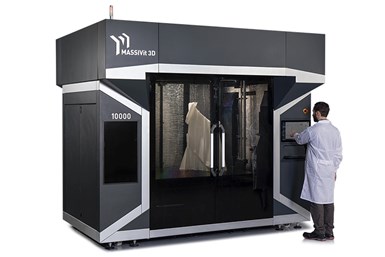Massivit 10,000 Additive Tooling System for Composites Manufacturing
Rapid + TCT 2022: The system utilizes the the company’s Cast In Motion technology, which is said to enable direct printing of complex molds using high-performance casting materials.

Massivit 3D’s 10,000 additive tooling system. Photo Credit: Massivit 3D
Massivit 3D’s 10,000 additive tooling system is designed to overcome bottlenecks in composite materials manufacturing. Based on the company’s Cast In Motion (CIM) technology, the system is said to enable direct printing of complex molds using high-performance casting materials. The technology is said to shorten tooling production time by 80%, reduce costs and decrease material waste associated with traditional tooling methods.
In addition to facilitating direct printing of molds, the enables fast production of complex prototypes, mandrels and plugs, the company says. The system is also said to empower composite fabricators to digitally produce complex, custom molds within a matter of days, instead of weeks. The CIM technology is said to combine ultrafast, additive manufacturing (AM) with high-performance, thermoset casting materials to enable automated tooling for composites.
It is said large tools and molds traditionally used for producing fiber-reinforced composite parts can be expensive, slow-to-build, wasteful and require extensive manual skilled labor. The 10,000 is said to offer market time- and cost-saving benefits for the manufacturing of large tooling, including simplified production and higher yield, simplified supply chain and reduced required stocks, and reduced waste of expensive materials.
The system process begins with an outer, sacrificial shell 3D printed with a water-breakable gel using Massivit 3D’s Gel Dispensing Printing Technology (GDP). A thermoset epoxy material (which is said to have high mechanical and thermal properties) is cast into that shell, forming an isotropic mold. Once the 3D printed tool is immersed in plain water, the sacrificial shell crumbles away, leaving the desired mold, ready to use.
Technical advantages are said to include design freedom which enables allows mold production of function-oriented, intricate geometries. The system is said to enable better and faster tool design cycles, including many features to reduce iterations. The CAD part to CAD mold design is said to enable improved accuracy, consistency and higher reliability. Users are also said to achieve true isotropy as well as high mechanical and thermal properties at elevated temperatures.
Related Content
-
3D Printed Human-Operated End-of-Arm Tooling Promotes Safety and Throughput
Toolmaker and injection molder Zero Tolerance developed a manual tool to enable an operator to quickly place inserts into a mold.
-
3D Printed Preforms Improve Strength of Composite Brackets: The Cool Parts Show Bonus
On this episode, we look at a pin bracket for the overhead bin of an airplane made in two composite versions: one with continuous fiber 3D printed reinforcements plus chopped fiber material, and one molded from chopped fiber alone.
-
Video: Reinforcing (and Joining) Parts After 3D Printing
Reinforce 3D has developed a method that can be applied to strengthen 3D printed parts by feeding continuous fiber and resin through them. The technique also enables joining parts of various materials and manufacturing methods.













